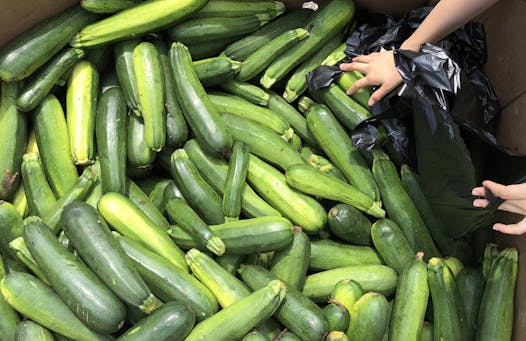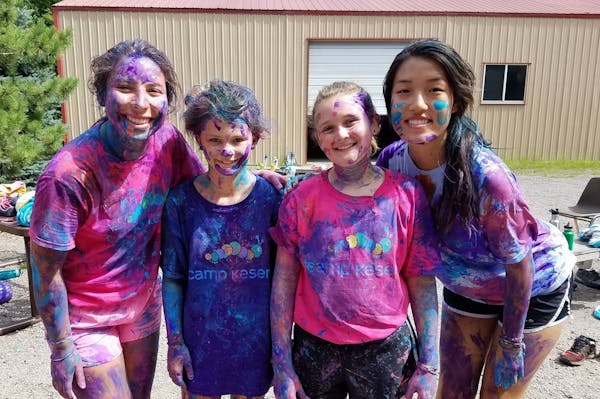MANKATO – The sheepish students followed the parking lot procession, picking up bags filled with zucchini, corn, red potatoes and bread.
Kolten Espinosa, a 20-year-old from New York City, envisioned a stir fry of fresh vegetables in his future — a welcome break from the norm for many college students. He also grabbed an unwieldy watermelon for his girlfriend, a big fan of the fruit.
"How many people eat 35 watermelons?" said Espinosa, who is studying civil engineering at Minnesota State University, Mankato.
It's likely that many students would, if they could. Espinosa was attending the university's Free Farmers Market on Aug. 23, an event that drew more than 200 students. The event is an extension of the campus food pantry, Campus Cupboard. The cupboard allows students to pack a bag of groceries once a week, and "pay it forward" when they are able to at a later date.
Across the nation, people are increasingly turning to food shelves to supplement their budgets and put food on the table. Last year, Minnesotans across the state visited food shelves a record 3.4 million times.
Among that growing population: College students.
At Minnesota State, nearly two-thirds of surveyed students said they missed meals in the past semester due to food insecurity. National studies report similar numbers.
A growing problem
Students surviving in college on ramen noodles and pizza is hardly new. What is new is that universities are no longer shrugging off the issue. Food insecurity on a college campus can be anything from missing a few meals to forgoing meals several dozen times in a semester.
"There was almost a mythology that starving was part of being in college, like, you don't deserve to have the food," said Sophia Lenarz-Coy, associate director of Hunger Solutions Minnesota, a nonprofit that tracks food insecurity issues at more than 300 Minnesota food shelves.
"To me, that myth is starting to be overturned or, at least, campuses are paying more attention to it."
In fact, many colleges and universities have opened food pantries and created resource positions or centers to connect students with additional services, such as housing assistance.
"People care here," said Karen Anderson, assistant director for community engagement at Mankato State. "It just takes people stepping up and saying, 'I need a little help.' "
While efforts are concentrated in the Twin Cities, universities across the state have established programs to address food insecurity, Lenarz-Coy said. In 2011, for example, Jesse Stirewalt noticed a troubling theme as he walked through the dorms of Fond du Lac Tribal and Community College in Cloquet. Each apartment had a kitchen. But when he opened the pantries, they were empty.
Stirewalt, director of housing and student activities, started the Bruce Carlson Food Pantry in January 2012, forming a partnership with Second Harvest Heartland, which brings him about 1,000 pounds of food once or twice a month.
"It's filling stomachs," Stirewalt said. "It's helping students out. It's providing comfort."
SNAP to it
Another potentially good option that many students overlook is the Supplemental Nutrition Assistance Program (SNAP), formerly called food stamps. Money for groceries comes preloaded on a plastic card that resembles a debit card.
It's hard to overstate how vital SNAP has become for struggling students and others, Lenarz-Coy said. For every meal provided by charitable organizations, SNAP provides 12 meals.
But, for students without disabilities to qualify, SNAP generally requires that they work 20 hours a week and have a low-enough income. Some exceptions do apply, such as if the student is taking care of a dependent household member under age 6, or taking part in a state or federally financed work-study program.
Again, though, students must step up and ask for help, which can be a challenge. Anderson, the community engagement specialist, said that many students don't feel like their need is as severe as others, or feel afraid to reckon with it.
"There's still a stigma of asking for help that's difficult to overcome," she said.
Part of that reluctance is fueled by the inherent tie between socializing and spending money, said Connor Davis, a 21-year-old junior civil engineering student at Minnesota State.
A slew of advertisements for everything from sports games to lectures to special events bombard students every day. "[You think] maybe I should go out, too," Davis said. "And then you get there, and you get a glass of water."
Ultimately, it's important that officials educate students, and their families, about what is available to them, Lenarz-Coy said.
"If students are having a hard time qualifying for that public benefit program, and are forced to rely just on charitable solutions," she said, "they really are at a disadvantage really quickly.
"There are pockets where it's being done really, really well," she said. "But there's also a ways to go."
Room to grow
Despite increasing visits statewide, Lenarz-Coy noted that food shelves are struggling to maintain donors' attention as the economy appears to have recovered. She and others emphasize that addressing food insecurity in the college setting is just the first step to broader understanding of stubborn food insecurity overall.
A recent Urban Institute survey of nearly 7,600 adults, for example, found that approximately 40 percent of U.S. families struggled to meet at least one of their basic needs in 2017, include paying for food.
Jean Bosco, a graduate student at Minnesota State originally from Rwanda, relies on food shelves and events like the Free Farmer's Market to feed his family of five. Coming to food shelves is how he and his wife plug that last hole in the budget puzzle.
While some people are bashful to ask for help, Bosco revels in the generosity he's experienced in this country.
His 7-year-old OraAnna Ntirenganya accompanied him to the farmers market and had already picked out fruits and vegetables. Now she was staring at a white-frosted birthday cake.
With a nod from her father, she grabbed the heavy pastry box, grinning as she carried it to the car.
It was for Dad, whose birthday was the following week.
"That's amazing," he said, smiling.
"When it comes to the food, those community services have always helped us."
US-Audiobooks-Top-10
Get better sleep with these 5 tips from experts
With graduation near, colleges seek to balance safety and students' right to protest Gaza war
Lithuanian soprano Asmik Grigorian makes belated Metropolitan Opera debut as Madame Butterfly



